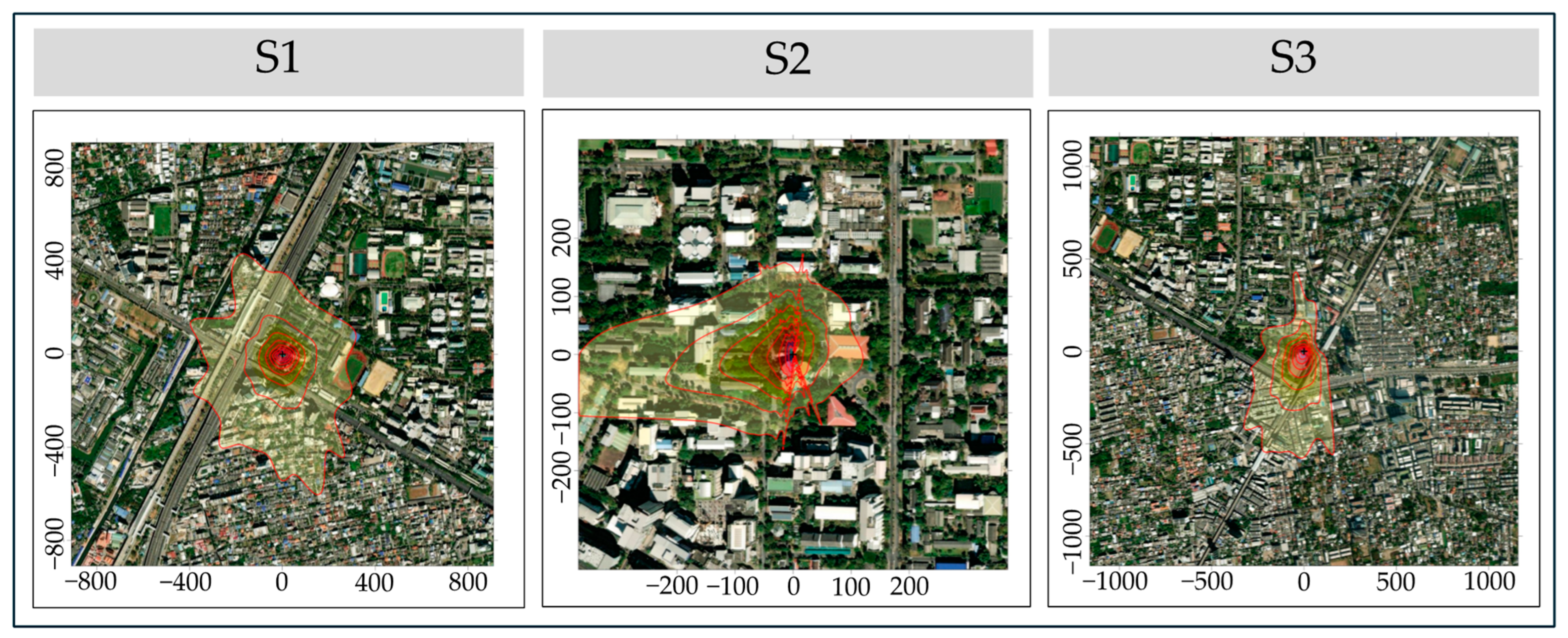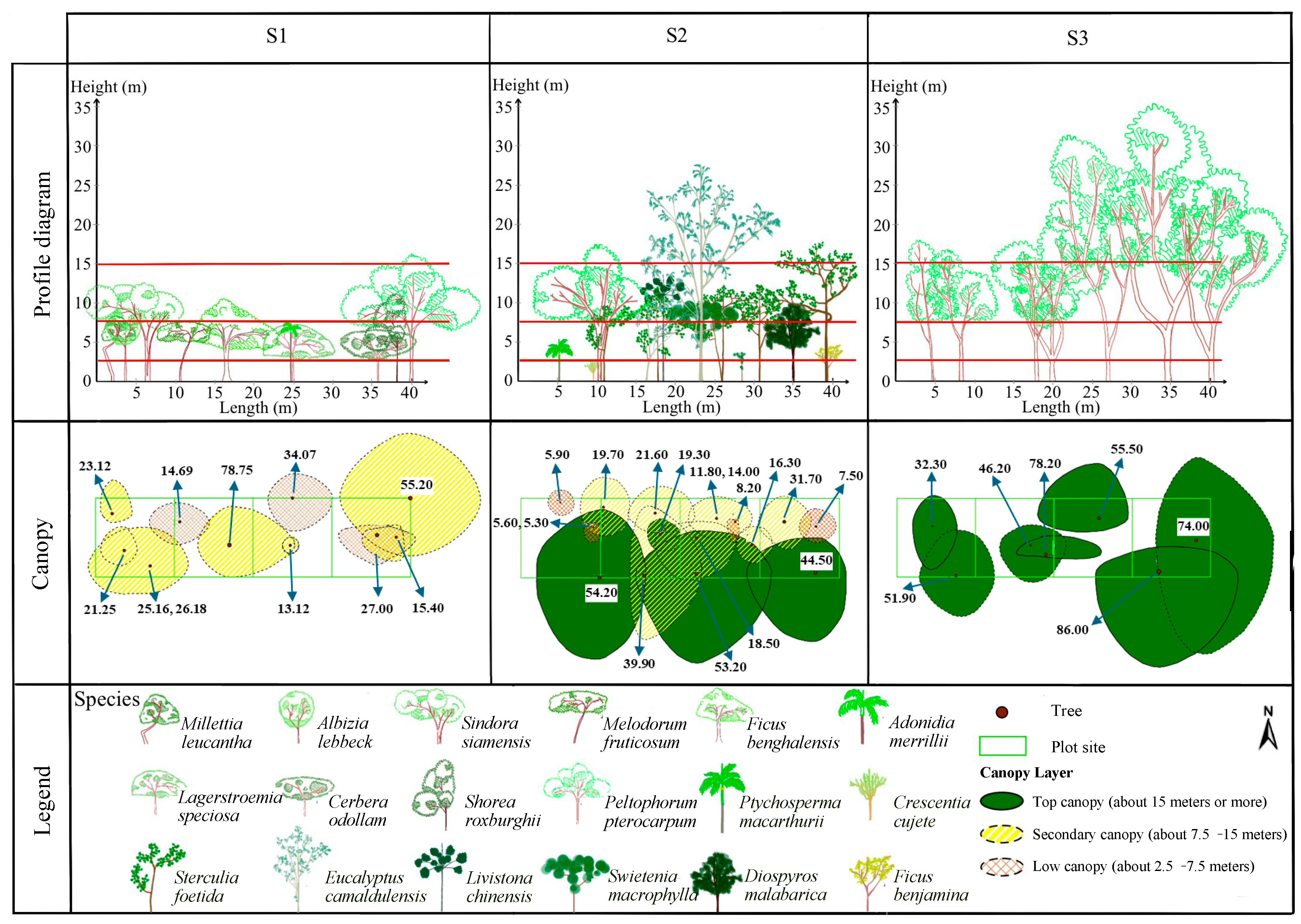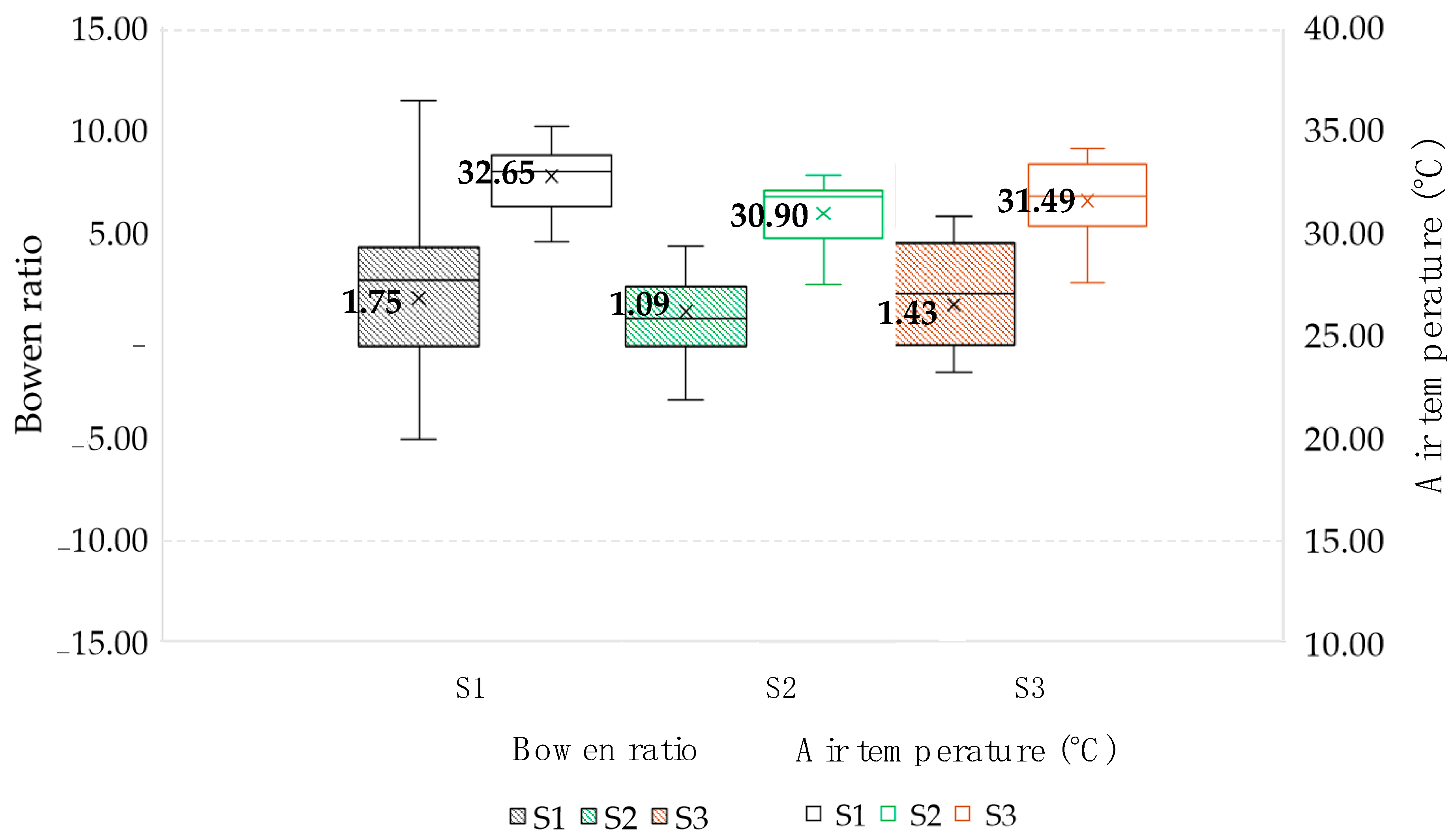Investigating the Effects of Tropical Plant Community Structures on Energy Exchange in Urban Green Areas for Climate Change Adaptation and Mitigation
Abstract
:1. Introduction
2. Materials and Methods
2.1. Site Description
2.2. Plant Community Analysis
2.3. Energy Balance and Bowen Ratio Analysis
- Q* = net radiation flux, Wm−2;
- QH = sensible heat flux, Wm−2;
- QE = latent heat flux, Wm−2;
- QG = ground heat flux, Wm−2;
- ∆QS = storage period by plant, building, etc., Wm−2.
3. Results and Discussion
3.1. Characteristics of Plant Community Structure in Green Areas
3.2. Changes in the Net Energy and Energy Exchange between the Atmosphere and the Surface
3.3. Effects of Plant Community Structure in Green Areas on Energy Exchange
4. Conclusions
Author Contributions
Funding
Data Availability Statement
Acknowledgments
Conflicts of Interest
References
- Land Development Department. Summary of Land Use Types Bangkok Province, Year 2019. Available online: http://www1.ldd.go.th/web_OLP/Lu_62/Lu62_C/BKK2562.htm (accessed on 22 October 2023).
- National Statistical Office. Vehicle Registration Statistics of the Department of Land Transport Classified by Registration Act. 2020. Available online: http://ittdashboard.nso.go.th/preview.php?id_project=126 (accessed on 12 March 2023).
- Adulkongkaew, T.; Satapanajaru, T.; Charoenhirunyingyos, S.; Singhirunnusorn, W. Effect of land cover composition and building configuration on land surface temperature in an urban-sprawl city, case study in Bangkok Metropolitan Area, Thailand. Heliyon 2020, 6, e04485. [Google Scholar] [CrossRef]
- Pakarnseree, R.; Chunkao, K.; Bualert, S. Physical characteristics of Bangkok and its urban heat island phenomenon. Build. Environ. 2018, 143, 561–569. [Google Scholar] [CrossRef]
- Chen, H.C.; Huang, J.J.; Liang, H.; Wang, W.; Li, H.; Wei, Y.; Jiang, A.Z.; Zhang, P. Can evaporation from urban impervious surfaces be ignored? J. Hydrol. 2023, 616, 128582. [Google Scholar] [CrossRef]
- Sidiqui, P.; Roös, P.B.; Herron, M.; Jones, D.S.; Duncan, E.; Jalali, A.; Allam, Z.; Roberts, B.J.; Schmidt, A.; Tariq, M.A.U.R.; et al. Urban Heat Island vulnerability mapping using advanced GIS data and tools. J. Earth Syst. Sci. 2022, 131, 266. [Google Scholar] [CrossRef]
- Elliott, H.; Eon, C.; Breadsell, J.K. Improving City Vitality through Urban Heat Reduction with Green Infrastructure and Design Solutions: A Systematic Literature Review. Buildings 2020, 10, 219. [Google Scholar] [CrossRef]
- Suchatanon, P.; Bualert, S.; Kannasoot, S. Variation of energy balance in different Green Areas. Thai J. For. 2015, 34, 3–41. [Google Scholar]
- Ramamurthy, P.; Bou-Zeid, E. Heatwaves and urban heat islands: A comparative analysis of multiple cities. J. Geophys. Res. Atmos. 2016, 122, 168–178. [Google Scholar] [CrossRef]
- Maskooni, E.K.; Hashemi, H.; Berndtsson, R.; Arasteh, P.D.; Kazemi, M. Impact of spatiotemporal land-use and land-cover changes on surface urban heat islands in a semiarid region using Landsat data. Int. J. Digit. Earth 2021, 14, 250–270. [Google Scholar] [CrossRef]
- Waiworagit, S.; Buranakarn, V. Influenced factors of heat island effect temperature increase: Case study Pathum Thani province, Thailand. Int. J. Sci. Innov. Technol. 2021, 4, 26–33. [Google Scholar]
- Maskulrath, P.; Bualert, S.; Szymanski, W.W.; Choomanee, P.; Chunkao, K.; Pattamapitoon, T.; Saiohai, J.; Phupijit, J.; Utavong, T.; Rattanapotanan, T.; et al. Assessment of urban green areas towards changing surface energy balance fluxes in tropical study sites, Central Thailand. Environ. Chall. 2023, 11, 100715. [Google Scholar] [CrossRef]
- Zhou, W.; Yu, W.; Zhang, Z.; Cao, W.; Wu, T. How can urban green spaces be planned to mitigate urban heat island effect under different climatic backgrounds? A threshold-based perspective. Sci. Total Environ. 2023, 890, 164422. [Google Scholar] [CrossRef] [PubMed]
- Hamada, S.; Ohta, T. Seasonal variations in the cooling effect of urban green areas on surrounding urban areas. Urban For. Urban Green. 2010, 9, 15–24. [Google Scholar] [CrossRef]
- Oliveira, S.; Andrade, H.; Vaz, T. The cooling effect of green spaces as a contribution to the mitigation of urban heat: A case study in Lisbon. Build. Environ. 2011, 46, 2186–2194. [Google Scholar] [CrossRef]
- Aram, F.; García, E.H.; Solgi, E.; Mansournia, S. Urban green space cooling effect in cities. Heliyon 2019, 5, e01339. [Google Scholar] [CrossRef] [PubMed]
- Law, B.E.; Cascatti, A.; Baldocchi, D.D. Leaf area distribution and radiative transfer in open-canopy forests: Implications for mass and energy exchange. Tree Physiol. 2001, 21, 777–787. [Google Scholar] [CrossRef] [PubMed]
- Yang, R.; Friedl, M.A. Modeling the effects of three-dimensional vegetation structure on surface radiation and energy balance in boreal forests. J. Geophys. Res. Atmos. 2003, 108, 1–11. [Google Scholar] [CrossRef]
- Parker, G.G.; Harmon, M.E.; Lefsky, M.A.; Chen, J.; Pelt, R.V.; Weiss, S.B.; Thomas, S.C.; Winner, W.E.; Shaw, D.C.; Franklin, J.F. Three-dimensional structure of an old-growth Pseudotsuga-tsuga canopy and its implications for radiation balance, microclimate, and gas exchange. Ecosystems 2004, 7, 440–453. [Google Scholar] [CrossRef]
- McPherson, R.A. A review of vegetation—Atmosphere interactions and their influences on mesoscale phenomena. Prog. Phys. Geogr. 2007, 31, 216–285. [Google Scholar] [CrossRef]
- Ruezzene, C.B.; Parizotto, D.; Cidin, A.C.; Oliveira, D.d.; Pinto, T.J.d.S.; Crestana, S.; Miranda, R.B.d.; Mauad, F.F. Water balance and net radiation in forest and pasture area in Southwest Amazon. Santa Maria 2019, 23, 1–10. [Google Scholar] [CrossRef]
- Caioni, C.; Silvério, D.V.; Macedo, M.N.; Coe, M.T.; Brando, P.M. Droughts Amplify Differences Between the Energy Balance Components of Amazon Forests and Croplands. Ecohydrol. Remote Sens. 2020, 12, 525. [Google Scholar] [CrossRef]
- Hemery, G.E.; Savill, P.S.; Pryor, S.N. Applications of the crown diameter–stem diameter relationship for different species of broadleaved trees. For. Ecol. Manag. 2005, 215, 285–294. [Google Scholar] [CrossRef]
- Cain, S.A.; de Oliveira Castro, G.M. Manual of Vegetation Analysis; Harper: New York, NY, USA, 1959. [Google Scholar]
- Krebs, C.J. Ecology: The Experimental Analysis of Distribution and Abundance, 6th ed.; Eugene Hecht. Pearson Education, Inc. Pearson Benjamin Cummings: San Francisco, CA, USA, 2009. [Google Scholar]
- Foken, T.; Wimmer, F.; Mauder, M.; Thomas, C.; Liebethal, C. Some aspects of the energy balance closure problem. Atmos. Chem. Phys. 2006, 6, 4395–4402. [Google Scholar] [CrossRef]
- Mauder, M.; Foken, T.; Cuxart, J. Surface-Energy-Balance closure over land: A review. Bound.-Layer Meteorol. 2020, 177, 395–426. [Google Scholar] [CrossRef]
- Flux Footprint Prediction (FFP) Online Data Processing. Available online: https://geography.swansea.ac.uk/nkljun/ffp/www/upload.php (accessed on 12 December 2023).
- Nielsen, D.C.; Miceli-Garcia, J.J.; Lyon, D.J. Canopy Cover and Leaf Area Index Relationships for Wheat, Triticale, and Corn. Agron. J. 2012, 104, 1569–1573. [Google Scholar] [CrossRef]
- Raj, R.; Walker, J.P.; Pingale, R.; Nandan, R.; Naik, B.; Jagarlapudi, A. Leaf area index estimation using top-of-canopy airborne RGB images. Int. J. Appl. Earth Obs. Geoinf. 2021, 96, 102282. [Google Scholar] [CrossRef]
- Umaña, M.N.; Swenson, N.G.; Marchand, P.; Cao, M.; Lin, L.; Zhang, C. Relating leaf traits to seedling performance in a tropical forest: Building a hierarchical functional framework. Ecol. Soc. Am. 2021, 102, e03385. [Google Scholar] [CrossRef] [PubMed]
- Matuszko, D. Influence of the extent and genera of cloud cover on solar radiation intensity. Int. J. Climatol. 2012, 32, 2403–2414. [Google Scholar] [CrossRef]
- Intaraksa, A.; Chunkao, K.; Bualert, S. Bowen Ratio Method for Measuring Heat Transfer on Land Cover Change in Establishing Green Patch in Urban Heat Island of Bangkok. Mod. Appl. Sci. 2014, 8, 158–173. [Google Scholar] [CrossRef]
- Li, Q.; Hou, J.; He, N.; Xu, L.; Zhang, Z. Changes in leaf stomatal traits of different aged temperate forest stands. J. For. Res. 2021, 32, 927–936. [Google Scholar] [CrossRef]
- Wang, C.; He, J.; Zhao, T.-H.; Cao, Y.; Wang, G.; Sun, B.; Yan, X.; Guo, W.; Li, M.-H. The Smaller the Leaf Is, the Faster the Leaf Water Loses in a Temperate Forest. Front. Plant Sci. 2019, 10, 58. [Google Scholar] [CrossRef]
- Yin, J.; Wu, X.; Shen, M.; Zhang, X.; Zhu, C.; Xiang, H.; Shi, C.; Guo, Z.; Li, C. Impact of urban greenspace spatial pattern on land surface temperature: A case study in Beijing metropolitan area, China. Landsc. Ecol. 2019, 34, 2949–2961. [Google Scholar] [CrossRef]
- Egipto, R.J.L.; Aquino, A.; Andújar, J.M. Predicting the canopy conductance to water vapor of grapevines using a biophysical model in a hot and arid climate. Front. Plant Sci. 2024, 15, 1334215. [Google Scholar] [CrossRef]
- Wang, W.; Smith, J.A.; Ramaurthy, P.; Baeck, M.L.; Bou-Zeid, E.; Scanlon, T.M. On the correlation of water vapor and CO2: Application to flux partitioning of evapotranspiration. Water Resour. Res. 2016, 52, 9452–9469. [Google Scholar] [CrossRef]
- Morris, K.I.; Chan, A.; Ooi, M.C.; Oozeer, M.Y.; Abakr, Y.A.; Morris, K.J.K. Effect of vegetation and waterbody on the garden city concept: An evaluation study using a newly developed city, Putrajaya, Malaysia. Comput. Environ. Urban Syst. 2016, 58, 39–51. [Google Scholar] [CrossRef]
- Hui, L.C.; Chu, L.M. Identifying suitable tree species for evapotranspiration covers of landfills in humid regions using seedlings. Urban For. Urban Green. 2019, 38, 157–164. [Google Scholar] [CrossRef]
- Ouyang, L.; Gao, J.; Zhao, P.; Rao, X. Species-specific transpiration and water use patterns of two pioneer dominant tree species under manipulated rainfall in alow-subtropical secondary evergreen forest. Ecohydrology 2020, 13, e2234. [Google Scholar] [CrossRef]
- Targino, A.C.; Coraiola, G.C.; Krecl, P. Green or blue spaces? Assessment of the effectiveness and costs to mitigate the urban heat island in a Latin American city. Theor. Appl. Climatol. 2019, 136, 971–984. [Google Scholar] [CrossRef]
- Taksadipong, S.; Chuntranuluk, S.; Rungratanaubon, T. Investigation of cooling effect of urban green area on air temperature and relative humidity. Asia-Pac. J. Sci. Technol. 2017, 18, 960–970. [Google Scholar]
- Ramírez-Cuesta, J.M.; Consoli, S.; Longo, D.; Longo-Minnolo, G.; Intrigliolo, D.S.; Vanella, D. Influence of short-term surface temperature dynamics on tree orchards energy balance fluxes. Precis. Agric. 2022, 23, 1394–1412. [Google Scholar] [CrossRef]





| Station | Code | Latitude | Longitude | Ground Area | Water Area | Total Area (m2) | Detail | Measurement Date |
|---|---|---|---|---|---|---|---|---|
| Varunawan Garden | S1 | 13°50′51.71″ N | 100°33′47.04″ E | 8540.92 | 5100.74 | 13,641.66 | forest plantation | 23–28 April 2022 |
| 100-Year Garden of Luang Suwan Vajokkasikit | S2 | 13°50′50.97″ N | 100°34′15.24″ E | 7415.73 | 1846.84 | 9262.57 | forest plantations, herb garden, and arboretum | 1–6 June 2022 |
| Phaholyothin Garden | S3 | 13°50′29.58″ N | 100°34′32.88″ E | 17,239.41 | 8781.45 | 26,020.86 | typical garden | 6–11 June 2022 |
| Site | Type | Species (Numbers) | Number (Trees) | Species Diversity Index | Canopy Layer (m2) | ||
|---|---|---|---|---|---|---|---|
| Top | Secondary | Low | |||||
| S1 | Tree (7.5–15 m) | 7 | 7 | 2.30 | - | 419.01 | - |
| Tree (2.5–7.5 m) | 3 | 3 | - | - | 107.22 | ||
| S2 | Tree (>15 m) | 3 | 3 | 1.98 | 528.40 | - | - |
| Tree (7.5–15 m) | 5 | 8 | - | 335.89 | - | ||
| Tree (2.5–7.5 m) | 4 | 4 | 0.36 | - | - | 31.53 | |
| S3 | Tree (>15 m) | 1 | 7 | 756.70 | - | - | |
| Area | Plant Community Structure | Energy Balance (Mean ± SD) | Bowen Ratio (Day Time) | |||||||
|---|---|---|---|---|---|---|---|---|---|---|
| Species | Number of Trees | Basal Area | Relative Density of Trees (%) | Crown Cover (m2) | Q* | QH | QE | QG | ||
| S1 | 10 | 10 | 1.11 | 50.00 | 526.23 | 209.49 ± 178.94 | 155.75 ± 17.53 | 49.94 ± 28.20 | 3.79 ± 6.43 | 1.75 |
| (100%) | (73.16%) | (25.03%) | (1.81%) | |||||||
| S2 | 9 | 15 | 1.00 | 88.24 | 895.81 | 102.36 ± 106.92 | 53.10 ± 10.37 | 46.04 + 26.63 | 3.22 ± 9.80 | 1.09 |
| (100%) | (51.88%) | (44.98%) | (3.15%) | |||||||
| S3 | 1 | 7 | 2.20 | 100.00 | 756.70 | 271.75 ± 230.02 | 185.01 ± 32.81 | 81.83 + 35.36 | 4.91 ± 16.79 | 1.43 |
| (100%) | (68.08%) | (30.11%) | (1.81%) | |||||||
Disclaimer/Publisher’s Note: The statements, opinions and data contained in all publications are solely those of the individual author(s) and contributor(s) and not of MDPI and/or the editor(s). MDPI and/or the editor(s) disclaim responsibility for any injury to people or property resulting from any ideas, methods, instructions or products referred to in the content. |
© 2024 by the authors. Licensee MDPI, Basel, Switzerland. This article is an open access article distributed under the terms and conditions of the Creative Commons Attribution (CC BY) license (https://creativecommons.org/licenses/by/4.0/).
Share and Cite
Ruckchue, R.; Choomanee, P.; Bualert, S.; Rungratanaubon, T.; Fungkeit, Y.; Maskulrath, P. Investigating the Effects of Tropical Plant Community Structures on Energy Exchange in Urban Green Areas for Climate Change Adaptation and Mitigation. Urban Sci. 2024, 8, 74. https://doi.org/10.3390/urbansci8030074
Ruckchue R, Choomanee P, Bualert S, Rungratanaubon T, Fungkeit Y, Maskulrath P. Investigating the Effects of Tropical Plant Community Structures on Energy Exchange in Urban Green Areas for Climate Change Adaptation and Mitigation. Urban Science. 2024; 8(3):74. https://doi.org/10.3390/urbansci8030074
Chicago/Turabian StyleRuckchue, Rutsawadee, Parkpoom Choomanee, Surat Bualert, Thitima Rungratanaubon, Yossakorn Fungkeit, and Parkin Maskulrath. 2024. "Investigating the Effects of Tropical Plant Community Structures on Energy Exchange in Urban Green Areas for Climate Change Adaptation and Mitigation" Urban Science 8, no. 3: 74. https://doi.org/10.3390/urbansci8030074
APA StyleRuckchue, R., Choomanee, P., Bualert, S., Rungratanaubon, T., Fungkeit, Y., & Maskulrath, P. (2024). Investigating the Effects of Tropical Plant Community Structures on Energy Exchange in Urban Green Areas for Climate Change Adaptation and Mitigation. Urban Science, 8(3), 74. https://doi.org/10.3390/urbansci8030074







